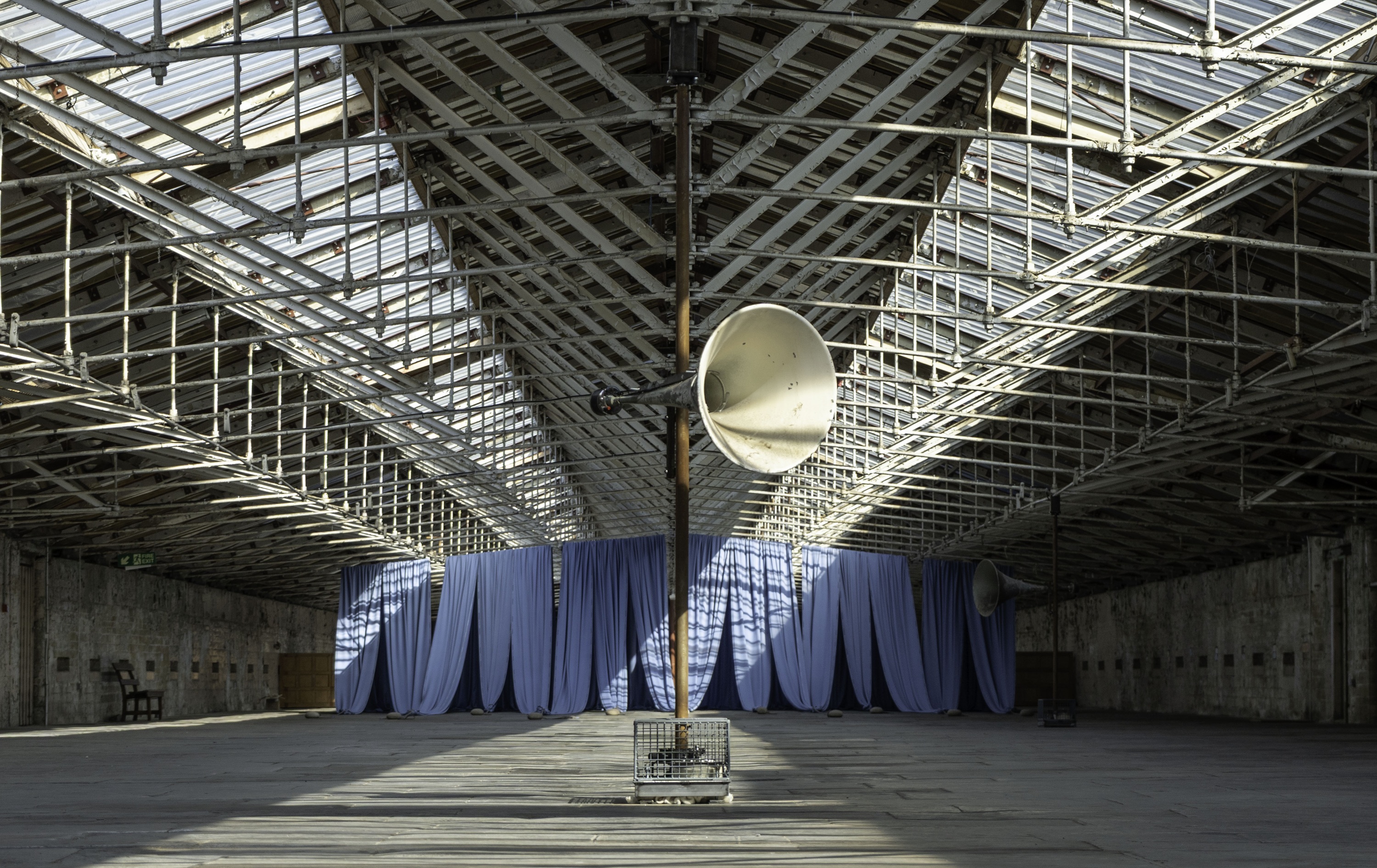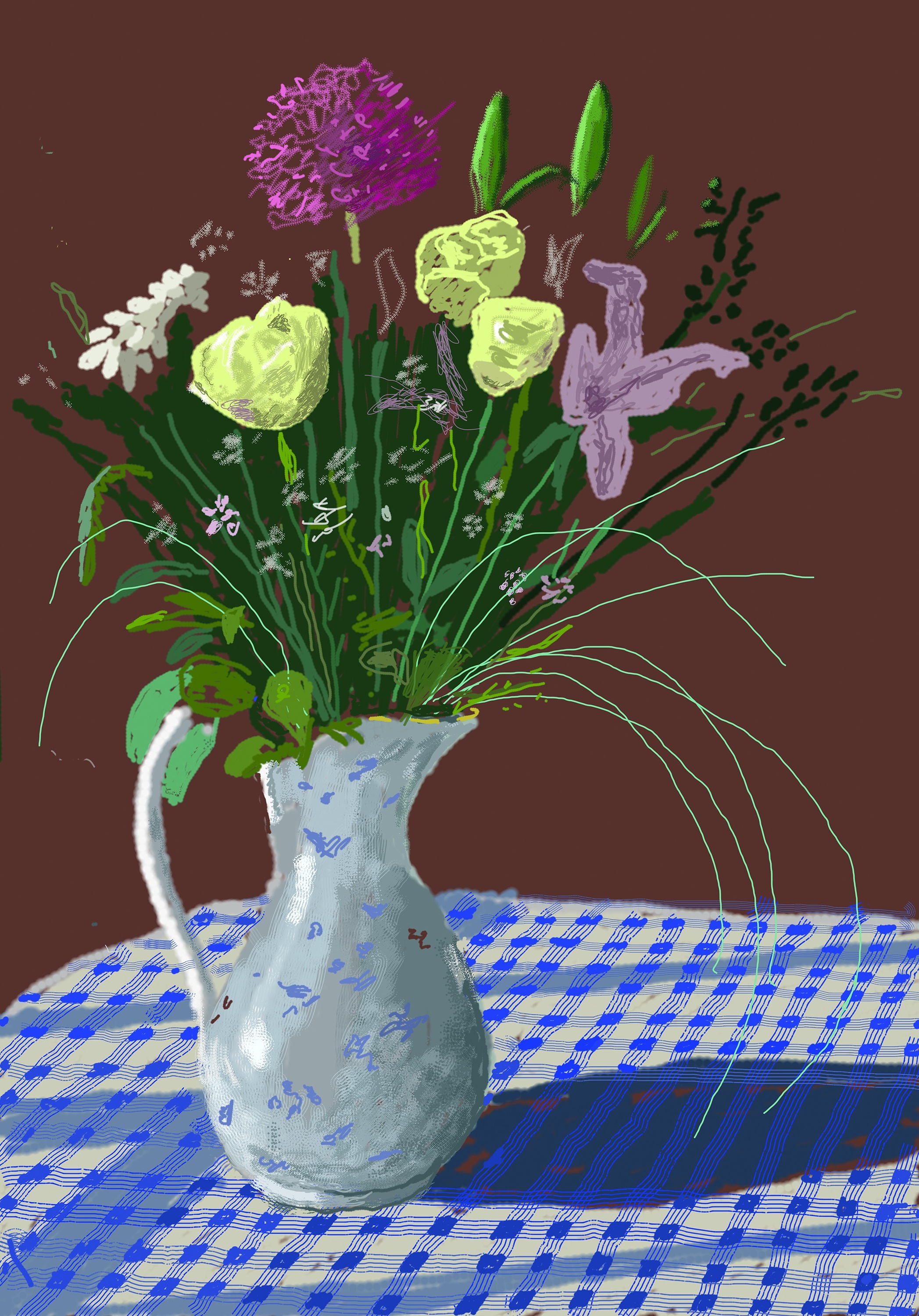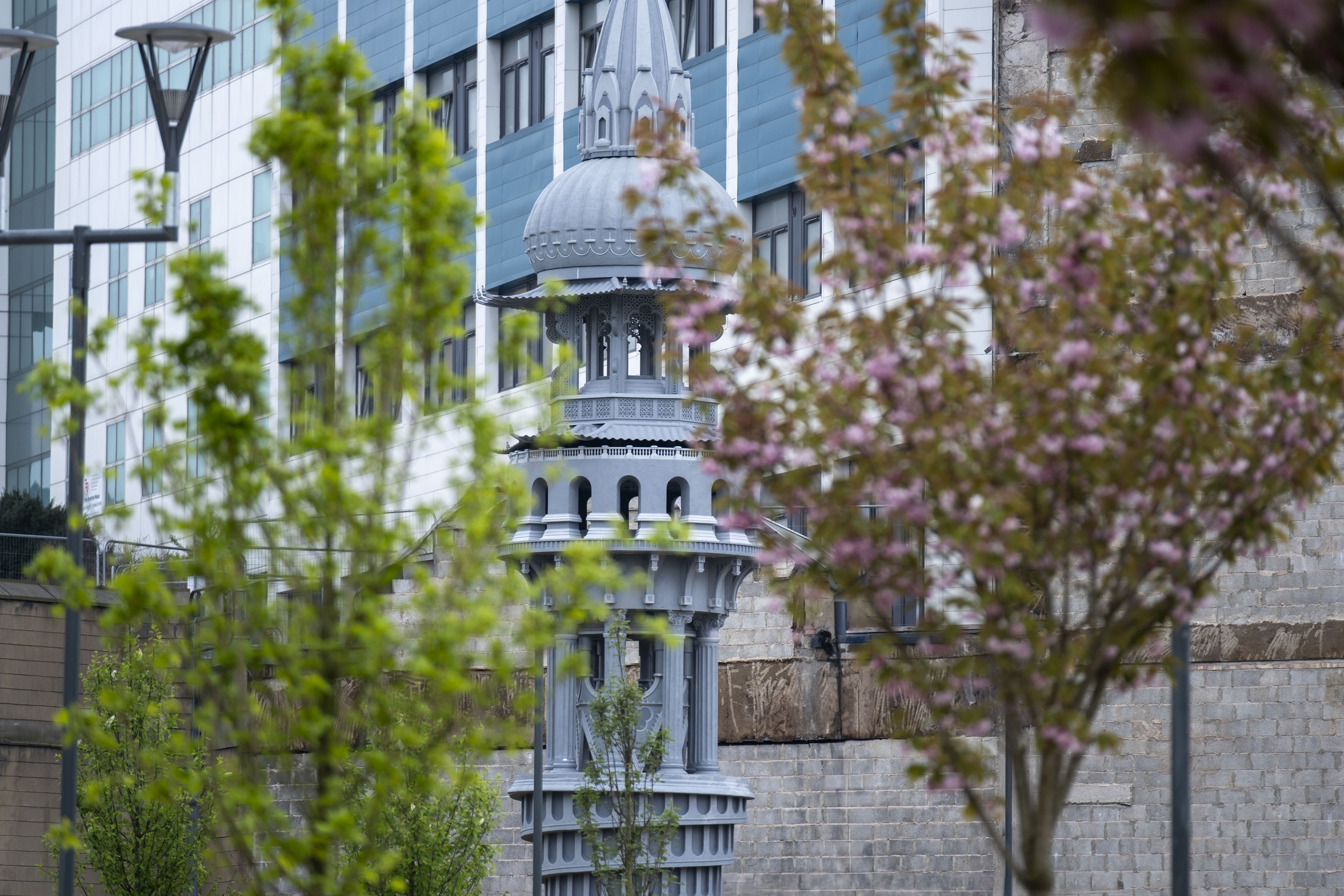Bradford City of Culture 2025 review - new magic conjured from past glories | reviews, news & interviews
Bradford City of Culture 2025 review - new magic conjured from past glories
Bradford City of Culture 2025 review - new magic conjured from past glories
City, mill and moor inspire the city's visual arts offering
Botanical forms, lurid and bright, now tower above a footpath on a moor otherwise famed for darkness and frankly terrible weather. But the trio of 5m-high contemporary sculptures grow in place here, drawing life from limestone soil. These metallic buds, blooms and supersize tubers reflect a deep, tropical past that predates the very English landscape we now associate with this part of the world.
So artist Vanessa da Silva invites you to reconnect with 300 million years of history by sitting here a while. When the sun is out, as it was on the opening weekend of Bradford 2025, you might reflect that the climate on Penistone Hill is not what you would expect (main picture: Muamba Posy by Vanessa da Silva).
In the valley is Haworth, once home to all three of the North Pennine Hills’ genii loci. The Brontë sisters lived here, in a parsonage now a museum. It has been lovingly reconstructed with such marvels as a dining table at which both Jane Eyre and Wuthering Heights were written. In half a dozen intimate rooms, domestic scenes look unchanged. But adjacent to the building, there are, for the first time, a very clean and amenable block of public toilets – remarkably, the first such conveniences at this hugely popular site of pilgrimages. It was built to support the City of Culture. After Haworth you can climb the moor and consider the visual art. There are four works including da Silva’s colourful intervention. The path leads you to encounter more international artists. Steve Messam, Meherunnisa Asad and Monira Al Qadari all bring eclectic vision to bear on the Brontë’s characteristic landscape. Reflecting the city’s history of textiles and the ovine denizens of the surrounding gorse, Messam has built a triumphal arch from plywood and coated with wool. Asad staggers the visitor with some 50 rose-tinted, marble butterflies; hand-crafted in Pakistan with incredible skill, they have made a resilient journey to alight on the shore of a hillside tarn here. Al Qadari conjures a cast of medieval djinns from a notorious local hoax, the Cottingley Fairies; her medieval fable-cast are arrayed across a landscape that still evokes fateful carriage rides, abandoned ravings and the passions that drive a past era’s most famous literary characters.
After Haworth you can climb the moor and consider the visual art. There are four works including da Silva’s colourful intervention. The path leads you to encounter more international artists. Steve Messam, Meherunnisa Asad and Monira Al Qadari all bring eclectic vision to bear on the Brontë’s characteristic landscape. Reflecting the city’s history of textiles and the ovine denizens of the surrounding gorse, Messam has built a triumphal arch from plywood and coated with wool. Asad staggers the visitor with some 50 rose-tinted, marble butterflies; hand-crafted in Pakistan with incredible skill, they have made a resilient journey to alight on the shore of a hillside tarn here. Al Qadari conjures a cast of medieval djinns from a notorious local hoax, the Cottingley Fairies; her medieval fable-cast are arrayed across a landscape that still evokes fateful carriage rides, abandoned ravings and the passions that drive a past era’s most famous literary characters.
Local legend also has it that circa 1850, about the time Heathcliffe and Cathy were in the midst of their diabolical courtship, nearby Bradford was one of the richest cities in the world. Textiles were the major export and mill owners were so conspicuous that model villages were named after them; as recently as 1922 the poet TS Eliot would – in Part III of The Wasteland – decry these stock characters for wearing "silk hats" with gross self-assurance. A certain Titus Salt is, these days, the most visible of these assured men; and, concurrent with the 19th century literary flowering, he was to also redefine this part of the world with an enduring legacy at Saltaire.
It would no doubt be to Eliot’s horror that this model industrial settlement built around a Grade II* listed mill building has since been made a UNESCO World Heritage Site. I cannot imagine what the high modernist poet would also think of the fact that Salt Mill is now a thriving and accessible arts centre with great cafés and an ever-changing programme of exhibitions. It has the UK’s only dedicated Peace Museum and also a bookshop with a very well-stocked, very prominent poetry section. Call it rebirth rather than literary irony.
On the top floor of this vast mill the American artist Ann Hamilton has installed an extensive site-responsive exhibition, with sound, called We Will Sing (pictured above). Stepping from stairwell and lobby, into the long-emptied factory floor, we are struck by an axis of shadows from the skylights, laddering the flagstones. Brickwork and girder supports are bare. Paint flakes from the iron rafters and the very dust seems historic. It is such an evocative space that it would have been a challenge to make any improvement at all.
Hamilton has managed to complement this desolate setting with three antique speaker cones, which revolve on rust-coloured supports. The mill’s top floor resounds to the plaintive sounds of unaccompanied solo folk song and cultivated melancholy whistling. The cones, surely not that different from speakers once used to call local workers to their work, lure the present day visitor and, when turned towards you, drown you with a kind of mournful energy that is hard to shake. Further elements in further spaces includes newspaper pages hung on stillage frames, a series of floor-to-ceiling drapes printed with photos of tiny ceramic dolls once used in cake decor, and a lively broadcast shack from which a volunteer reads texts carefully chosen by the multimedia artist.
 No picture of culture in Bradford would be complete without the painter David Hockney. At the age of 87 he is still making work on the iPad and sends his natal city a bouquet – in the form of 20 floral still lives (pictured right: David Hockney, 20th February 2021, Jug with Flowers, iPad painting © David Hockney). These too can be found in Salt Mill, with several landscapes that remind you of his facility for depicting water. Also included is what he calls a cubist film which is a nine channel video piece assembled into one grid-like scene which depicts a journey through a West Yorkshire landscape during a season of snow.
No picture of culture in Bradford would be complete without the painter David Hockney. At the age of 87 he is still making work on the iPad and sends his natal city a bouquet – in the form of 20 floral still lives (pictured right: David Hockney, 20th February 2021, Jug with Flowers, iPad painting © David Hockney). These too can be found in Salt Mill, with several landscapes that remind you of his facility for depicting water. Also included is what he calls a cubist film which is a nine channel video piece assembled into one grid-like scene which depicts a journey through a West Yorkshire landscape during a season of snow.
While in Saltaire, a preview was staged for The Bradford Progress, a peripatetic musical artwork that was to begin at dawn on Ilkley Moor. From there it was to continue in various performances, including one which was to float down the Leeds and Liverpool Canal. It was to spend the night droning in a cemetery, and it was to continue for 36 hours. The mix of musical populism and art high jinx bore several hallmarks of Jeremy Deller, and indeed he was in Saltaire with collaborator Charles Hazlewood to remind us of the importance of vernacular culture.
In a Victorian bandstand, at which the mill workers of this village would once have enjoyed a break from the daily grind, two groups performed in the May sunshine. The eight vocalists in Song-Geet, in striking red dupatta wraps, were to bring pitch-perfect Eastern melodies to the sunlit Northern park. Following that, Hazelwood’s Paraorchestra – a collective of accomplished disabled and able-bodied musicians – performed Mozart as a wind ensemble: it was a perfect soundclash between imported cultures of thousands of millworkers and the aspirational gentility of many a mill owner. A final word must go to Saad Qureshi whose new landmark was inspired by architecture all across the multicultural city he calls home. The Tower of Now is a 15m matt grey spindle, which leads the eye up into the sky via an inverted tower of Babel, as imagined by Breughel (pictured above). Further crenelations reference local mosques, temples, churches, neo-classical civic institutions. Qureshi spins all this together with immaterial skeins that cross geographies and times. Bradford may never again be on the global rich list, but the city’s newest monument winds together city, mill, and moor to make this previously overlooked city, for 12 months at least, the centre of Britain’s cultural landscape.
A final word must go to Saad Qureshi whose new landmark was inspired by architecture all across the multicultural city he calls home. The Tower of Now is a 15m matt grey spindle, which leads the eye up into the sky via an inverted tower of Babel, as imagined by Breughel (pictured above). Further crenelations reference local mosques, temples, churches, neo-classical civic institutions. Qureshi spins all this together with immaterial skeins that cross geographies and times. Bradford may never again be on the global rich list, but the city’s newest monument winds together city, mill, and moor to make this previously overlooked city, for 12 months at least, the centre of Britain’s cultural landscape.
rating
Share this article
The future of Arts Journalism
You can stop theartsdesk.com closing!
We urgently need financing to survive. Our fundraising drive has thus far raised £49,000 but we need to reach £100,000 or we will be forced to close. Please contribute here: https://gofund.me/c3f6033d
And if you can forward this information to anyone who might assist, we’d be grateful.

Subscribe to theartsdesk.com
Thank you for continuing to read our work on theartsdesk.com. For unlimited access to every article in its entirety, including our archive of more than 15,000 pieces, we're asking for £5 per month or £40 per year. We feel it's a very good deal, and hope you do too.
To take a subscription now simply click here.
And if you're looking for that extra gift for a friend or family member, why not treat them to a theartsdesk.com gift subscription?
more Visual arts
 'We are bowled over!' Thank you for your messages of love and support
Much-appreciated words of commendation from readers and the cultural community
'We are bowled over!' Thank you for your messages of love and support
Much-appreciated words of commendation from readers and the cultural community
 Folkestone Triennial 2025 - landscape, seascape, art lovers' escape
Locally rooted festival brings home many but not all global concerns
Folkestone Triennial 2025 - landscape, seascape, art lovers' escape
Locally rooted festival brings home many but not all global concerns
 Sir Brian Clarke (1953-2025) - a personal tribute
Remembering an artist with a gift for the transcendent
Sir Brian Clarke (1953-2025) - a personal tribute
Remembering an artist with a gift for the transcendent
 Emily Kam Kngwarray, Tate Modern review - glimpses of another world
Pictures that are an affirmation of belonging
Emily Kam Kngwarray, Tate Modern review - glimpses of another world
Pictures that are an affirmation of belonging
 Kiefer / Van Gogh, Royal Academy review - a pairing of opposites
Small scale intensity meets large scale melodrama
Kiefer / Van Gogh, Royal Academy review - a pairing of opposites
Small scale intensity meets large scale melodrama
 Jenny Saville: The Anatomy of Painting, National Portrait Gallery review - a protégé losing her way
A brilliant painter in search of a worthwhile subject
Jenny Saville: The Anatomy of Painting, National Portrait Gallery review - a protégé losing her way
A brilliant painter in search of a worthwhile subject
 Abstract Erotic, Courtauld Gallery review - sculpture that is sensuous, funny and subversive
Testing the boundaries of good taste, and winning
Abstract Erotic, Courtauld Gallery review - sculpture that is sensuous, funny and subversive
Testing the boundaries of good taste, and winning
 Edward Burra, Tate Britain review - watercolour made mainstream
Social satire with a nasty bite
Edward Burra, Tate Britain review - watercolour made mainstream
Social satire with a nasty bite
 Ithell Colquhoun, Tate Britain review - revelations of a weird and wonderful world
Emanations from the unconscious
Ithell Colquhoun, Tate Britain review - revelations of a weird and wonderful world
Emanations from the unconscious
 Rachel Jones: Gated Canyons, Dulwich Picture Gallery review - teeth with a real bite
Mouths have never looked so good
Rachel Jones: Gated Canyons, Dulwich Picture Gallery review - teeth with a real bite
Mouths have never looked so good
 Yoshitomo Nara, Hayward Gallery review - sickeningly cute kids
How to make millions out of kitsch
Yoshitomo Nara, Hayward Gallery review - sickeningly cute kids
How to make millions out of kitsch
 Hamad Butt: Apprehensions, Whitechapel Gallery review - cool, calm and potentially lethal
The YBA who didn’t have time to become a household name
Hamad Butt: Apprehensions, Whitechapel Gallery review - cool, calm and potentially lethal
The YBA who didn’t have time to become a household name

Add comment